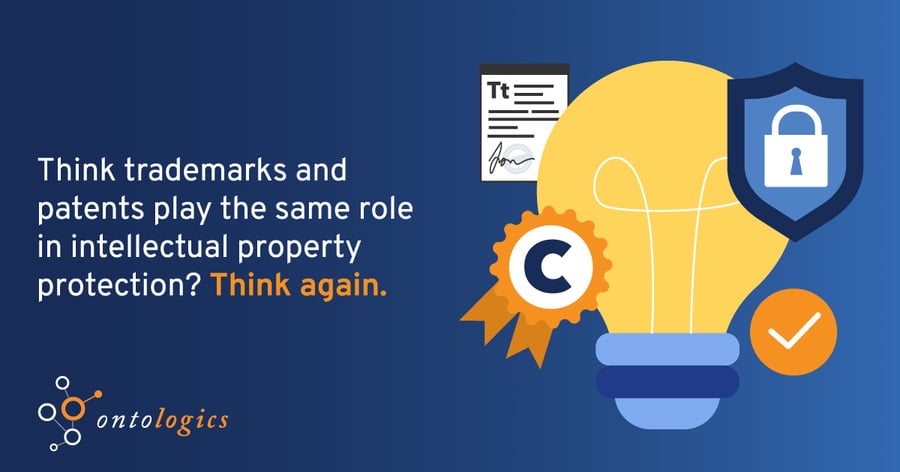27 Sep, 2023 • 3 min read
Trademark vs. Patent: What’s the Difference? | Ontologics

Trademark vs. Patent: What’s the Difference?
When you hear the terms trademark vs. patent, they sound pretty much the same – right? They aren’t. These two legal documents play equally important but unique roles in intellectual property law. In this blog, we’ll discuss the difference between patent and trademark protections, how they work, and the process behind obtaining each to help you better understand the importance of each for your business.
Patent vs. Trademark: Explained
Trademarks and patents are legal mechanisms designed to protect intellectual property, which are the ideas created through your business activities. They give you exclusive rights to use and exploit a specific design, product, or service for a set period.
The biggest source of confusion for many people is determining what trademark vs. patent protections actually apply to. Let's explore the characteristic differences between patent and trademark documentation:
What Is a Trademark?
Trademarks are used to protect brand names, logos, and other distinguishing features from being copied or used without permission. They are usually registered with the federal government but can also be registered in individual states.
The key differentiator to note here is that trademarks are specifically related to company branding and not the product itself. For example, a trademark would protect Coca-Cola's logo from being used without permission, but it cannot prevent other companies from making carbonated beverages or selling them in cans.
What Is a Patent?
Patents establish protections against replicating technical inventions – or products and systems – that are unique from those already used in a given industry. They are a way to secure the exclusivity of an invention and allow its creators to fully benefit from its commercialization.
Obtaining an official patent can be quite difficult, requiring not only completed documentation claiming ownership of the invention but also proving it is unique and novel. The US Patent and Trademark Office (USPTO) is part of the United States Department of Commerce and is responsible for granting patents.
Once an application has been submitted to the USPTO, it may take up to two years for approval and for a patent owner to receive exclusive rights. Patents are valid for 20 years from the date of application, after which point they expire and enter the public domain.
A Look at Patent and Trademark Law
Patents can be registered at both national and international levels, with local patents providing protection within a particular country or region and international patents offering protection in multiple countries. Most, if not all, established businesses will register their products' patents to fully protect them from being replicated or infringed.
Getting one for your own invention is no easy task. You will need to know the laws of the state you are in and what type of patent classification it falls under. It's highly recommended to consult an expert before pursuing this type of legal protection.
While difficult to obtain, patents will allow you to prevent others from using, making, selling, or importing your idea without permission. It will also give you exclusive rights to sell or be licensed for profit.
On a national level, trademark registration will prevent others from using your mark in the same industry or for similar products and services. It allows you to bring infringement actions against those who use it without permission and provides a legal presumption of ownership rights.
Trademarks may also be sold or transferred between entities. The process of transferring a trademark can be complex and involves multiple steps, such as filing documents with the USPTO or seeking court approval. It is essential to understand the various components of this process to adequately protect and transfer trademarks.
Tax Treatment of Patents and Trademarks
The tax treatment of patents and trademarks can be complicated. These official business documents are considered capital expenses, but the Internal Revenue Service (IRS) does not allow them to be deducted as a business expense in full.
Instead, businesses must amortize the costs incurred over the patent's useful life. The length of this period can vary depending on the type of patent or trademark in question but is typically between 10 and 20 years.
Streamline Your Business Trademarks and Patents With Ontologics
Taking the time to understand the difference between trademark and patent protection is by no means a waste of time. While it may not be the most exciting subject matter in the world, the more you understand these two forms of intellectual property protection, the better equipped you will be to protect your business’s valuable assets. In today's competitive and cut-throat landscape, that's as close to peace of mind as possible.
Ontologics empowers modern organizations to take advantage of trademarks and patents through a comprehensive suite of analytical tools. Research, anticipate, and capitalize upon your industry's next big innovation by scheduling a demo today.